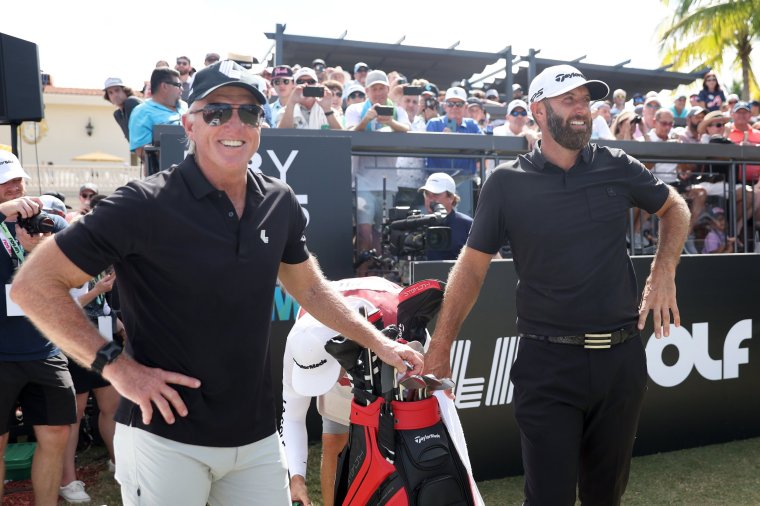LIV Golf will get under way for its second season with just one TV deal to its name after failing to attract major investment from broadcasters.
i has spoken to a number of TV companies who were approached by LIV but the consensus was that scheduling and political considerations outweighed the minimal commercial benefit expected.
Instead, viewers all over the world will watch the first event of the second LIV season, which starts in Mexico on Thursday, on the LIV Golf Plus app or via LIVGolfPlus.com, with the United States the only territory where it will be shown on linear television.
Even in the US, the event will be shown on The CW, a network better known for dramas like The Flash and Nancy Drew.
i understands that few TV companies did not receive some sort of pitch from representatives of the LIV series, but that there were stumbling blocks at every turn. More mainstream channels could not sanction committing the number of hours required to schedule in live coverage, even with LIV’s slimmed down format of 54 holes and shotgun starts.
That whittled the number of potential candidates down to dedicated sports networks and the streamers, but then politics – of the sporting kind – played its part. Sky has an existing PGA Tour deal, while BT Sport’s parent company Warner Bros Discovery still has a relationship with the PGA, despite recently handing back a portion of the 12-year deal they signed in 2023.
Paramount+, meanwhile, a growing player in the UK streaming market that draws from its owner CBS’s enormous content stream and has the financial heft to shop around in sports rights, also has a piece of the PGA Tour in the US as well as half of the Masters, making a LIV deal politically problematic. i understands its leadership also prefers global deals to region-by-region chopping up of rights.
And then there is the simple fact that the package LIV was offering – or more accurately, selling – had much to prove. The series has shelled out billions of dollars to poach players from the PGA Tour but, a year in, has yet to prove that it has created a product people want to watch. The big numbers for golf viewership remain the prize properties of the four majors and the Ryder Cup, at which LIV’s stars are increasingly unwelcome.
It was reported in January that LIV was even considering offering its rights for free in an effort to get any deal over the line, something that would at least have given it a chance of winning over some of the “floating voters” in golf’s traditional viewership.
“If you look at the WSL [Women’s Super League], look at their strategy, part of that was free-to-air and that built an audience,” Conrad Wiacek, head of sport analysis at GlobalData, tells i.
“Sky and the BBC now show WSL coverage because they’re trying to get as wide an audience as possible. The Hundred [cricket competition] is another example of this, free-to-air and coverage on pay TV.
“So you’re building that audience, you’re reaching as many people as you can through free-to-air, but you’ve also got potentially a bit of money coming in from the pay TV side.
“My gut feel is that LIV Golf have gone to market, they’ve signed all these big names, and they’ve gone ‘Well, of course, people are going to pay for this’ and the argument against that from a broadcaster, Sky especially, is ‘Okay, who’s your audience?’.
“LIV will say ‘Well, we don’t have one yet,’ and Sky will say ‘Well, come back to us when you do’ because in essence Sky will use that audience to sell advertising.
“There’s an entire economy behind media rights that I think LIV might have misjudged.”
LIV says broadcasting the competition through its own channels will help it build that audience.
Will Staeger, LIV Golf’s chief media officer, said: “In keeping with the content distribution strategy of other major sports leagues, the LIV Golf Plus streaming app allows more access to our content from more places for more people, spanning the traditional golf consumer to the casual sports and entertainment viewer discovering golf for the first time.”

But the financial blow of missing out on TV money, even for a series with such deep pockets, cannot be underestimated. Could you generously suggest that for all LIV’s meticulous planning and financial acumen, it is swimming against the tide of a global recession?
“We’re seeing plenty of sponsorship deals and things like that, so there’s plenty of money still out there. Marketing, sponsorship, advertising… these are ways of reaching an audience, connecting with their audience, and getting people to buy your product,” Wiacek adds.
“So while there might be cuts in that, there’s still plenty of money around.
“So is it a case of sort of building a different media rights strategy, to go to market and actually get people watching it.
“And then you can sit there and say, ‘Well, we’ve got an audience of half a million in the UK’, for example. You can build an audience, develop the audience from there.”
He says: “If you get 10 million people watching it, you’re in a very strong position. And that’s the reality of the situation.
“It didn’t hurt the WSL [giving it away for free], they walked away with a deal with Sky who are paying for rights. They still have an agreement with the BBC, they still show games and so on.
“But Sky is the main broadcaster for it, and they’re paying for it. That’s led to sponsorship deals – Barclays, the title sponsor of the WSL, and things like that.
“So just by doing that, you can sort of track that it’s generally a revenue generator.”

